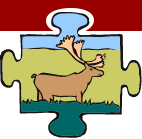|
Fish and Marine Life
|
Back
|
FISH QUALITY
Indicators
- Fish abundance and distribution
- Presence of diseases/parasites
- Water quality
- Contaminant levels
- Invertebrates/insects
- Fish health
Current Knowledge
The general well-being of fish is monitored in various lakes and rivers in the NWT, but there has not to date, been a coordinated or long-term program to monitor fish quality. Long-term monitoring has begun in Fort Good Hope, Great Slave Lake, and the Slave River.
Contaminants such as persistent organic pollutants (POPs) and heavy metals can be found in fish. POPs have been found in burbot at Fort Good Hope but levels have declined. Mercury is the metal of most concern, and consumption advisories have been issued for many lakes. Parasites also occur in fish and are considered a biological contaminant.
Changes in the occurrence of parasites and disease in fish are unknown, since these are not regularly monitored. Local fishers have made comments about the declining condition, taste and texture of local fish, but these have not yet been well documented.
Stress from physical and chemical disturbances to habitat, can cause the overall health of fish to decline.
Current Monitoring
- Lower Mackenzie River index-netting program – Fisheries and Oceans Canada (DFO)
- Contaminants in burbot from Fort Good Hope, NWT - DFO
- Contaminants and heavy metals in fish from Great Slave Lake and Slave River - Environment Canada (EC) and DFO
- Mercury in fish from lakes in the western NWT – DFO and EC
- Mercury in predatory fish in the Mackenzie River Basin – DFO and EC
- Contaminants and metals in fish in Great Bear Lake and Lac Ste. Therese – DFO
- Contaminants in burbot (loche) from the Aklavik Area - Arctic Borderlands Ecological Knowledge Co-op
- Marine mammal monitoring questionnaire in the Tuktoyaktuk and Aklavik areas - Arctic Borderlands Ecological Knowledge Co-op
Gaps and Recommendations
There is no information being collected regarding the overall physical health of fish and large gaps exist on contaminant information. Community-based monitoring of fish disease, parasites, and lamprey scars would be helpful since local fishers are most familiar with the general condition of fish. Community-based monitoring could also take into account indicators of the overall physical health of fish.
As recommended for the Fish Habitat and Water Quality VCs, monitoring of invertebrate (water bug) distribution and numbers would be useful. Monitoring linkages between water quality and fish diseases is also important. To see if fish quality changes over time, studies carried out in the 1970's could be repeated.
Source: A Preliminary State of Knowledge of Valued Components for the NWT Cumulative Impact Monitoring Program (NWT CIMP) and Audit. February 2002; updated February 2005.
For more details, you may also want to look at:
-
Fish Quality Excerpt
-
VC State of Knowledge Full Report
-
Projects on Fish Quality
- NWT Environmental Audit 2005 - Supplementary Report on the Status of the Environment
Top of page


